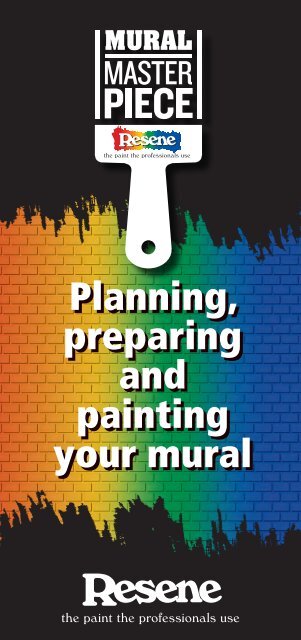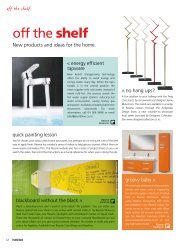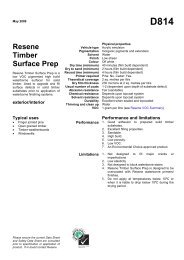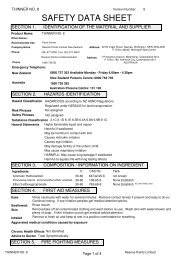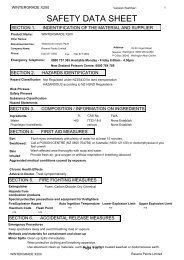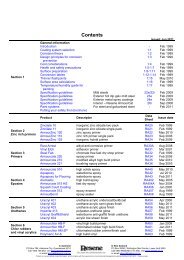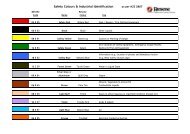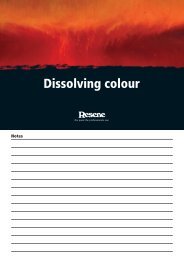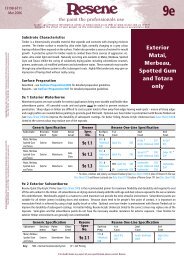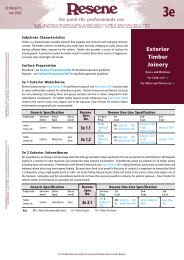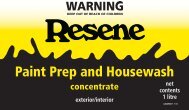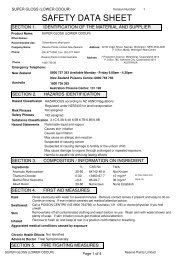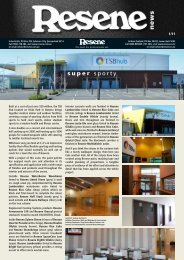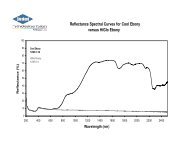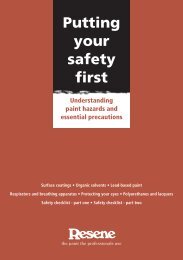Mural Masterpieces brochure - Resene
Mural Masterpieces brochure - Resene
Mural Masterpieces brochure - Resene
You also want an ePaper? Increase the reach of your titles
YUMPU automatically turns print PDFs into web optimized ePapers that Google loves.
Planning,<br />
preparing<br />
and<br />
painting<br />
your mural
Congratulations on your decision<br />
to create a mural - you’re<br />
about to embark on a project<br />
guaranteed to brighten up<br />
other people’s days!<br />
<strong>Mural</strong>s are a creative way to add colour<br />
and pride into a community, beautifying<br />
an area for all to enjoy.<br />
To help you create your mural, <strong>Resene</strong> has put together some<br />
tips and suggestions to get you started. If you have access to<br />
a professional muralist make the most of their knowledge to<br />
make the job easier and get the best result.<br />
Get your team together<br />
Gather together your team, allocate who is responsible for<br />
what and determine realistic deadlines for gathering materials<br />
and the date for the mural painting (ideally a weekend when<br />
team members are more likely to be free). If you have a mural<br />
site already in mind, a team visit would be a good idea. If not,<br />
one of the team’s first jobs can be looking for the site.<br />
Design your mural<br />
Brainstorm with your mural team to come up with a range of<br />
potential themes for your mural and then vote on the preferred<br />
option. Then let all team members loose with pen and paper<br />
to sketch out their interpretation of the theme. You will then<br />
have a range of options to select from, or you may wish to<br />
combine a number of the designs together. Or run your own<br />
competition with the winner having the joy of seeing their<br />
mural painted.<br />
Make sure the design is appropriate for the location - avoid<br />
words or images that may be offensive to others. Label the<br />
mural so that passing traffic knows why it was created and<br />
whom created it. Remember the mural will last a long time<br />
after you have finished.<br />
Find a mural site<br />
Search the local community for potential mural sites, noting<br />
the advantages and disadvantages of each. Contact building<br />
owners to determine whether the site is available for the<br />
mural. Make sure you have a second or third location available<br />
as the first option may not be available. In some communities,<br />
the council may be willing to help identify a suitable space for<br />
your mural.<br />
The ideal exterior surface is highly visible to the community,<br />
easily accessible, sound for painting and well lit.
Be realistic when choosing a location - if children are involved<br />
in the mural painting it may be better to pick a location with<br />
a longer mural and lower height so that all parts of the mural<br />
can be comfortably reached.<br />
If finding a site is difficult, you may decide to create a<br />
temporary moveable mural painted onto wood or canvas.<br />
Temporary murals can be displayed in different locations such<br />
as libraries and shopping malls before being installed in a<br />
permanent home, which may suit your plans better. As interior<br />
temporary murals are usually smaller, they are generally<br />
cheaper and easier to create as they can be painted indoors<br />
and require fewer materials.<br />
Organise materials<br />
Write a list of the materials you are likely to need to complete<br />
the mural, such as paint, brushes, dropcloths etc and<br />
determine the cost of the items. Many of these items, such as<br />
paintbrushes and dropcloths, can be borrowed from family,<br />
friends and neighbours and then returned clean at the end of<br />
the project. You may also wish to check with neighbours and<br />
friends and see whether they have any leftover <strong>Resene</strong> paint<br />
they don’t need.<br />
If you decide to hire a professional muralist, ask them to provide<br />
a quote for the job as this is likely to be your largest cost. If you<br />
are using volunteers, make sure you have at least one adult per<br />
10 children to assist with the organisation and painting.<br />
Community groups and local businesses may be able to<br />
support the mural with fundraising, publicity, volunteers and<br />
even the mural location. Send a letter to appropriate<br />
businesses and community groups outlining your plans, how<br />
any assistance they give will be recognised and arrange to<br />
follow them up within a couple of weeks for their response.<br />
Make sure you promote the assistance they have given you<br />
either on the mural or via any publicity you receive.<br />
Prepare the surface<br />
Now you have the location, the team, the design and the<br />
materials, it’s time to start painting! Make sure you prepare<br />
the wall properly first so that your hard work looks good for as<br />
long as possible.<br />
If your mural is being painted over old unpainted porous<br />
concrete, wash down the surface with <strong>Resene</strong> Paint Prep and<br />
Housewash and rinse clean with water. If moss and mould are<br />
present, use <strong>Resene</strong> Moss & Mould Killer. Allow to dry. Seal the<br />
surface using <strong>Resene</strong> Sureseal penetrating oil primer, then<br />
you’re ready to start painting.<br />
If your mural is being painted over an already painted surface,<br />
wash down the surface with <strong>Resene</strong> Paint Prep and<br />
Housewash. If moss and mould are present, use <strong>Resene</strong> Moss
& Mould Killer. Allow to dry. Check the surface is sound with<br />
no flaking or peeling. If it is, you can start applying topcoats<br />
over the existing paint.<br />
<strong>Mural</strong>s will generally last longest on a well prepared previously<br />
unpainted surface. If the surface you are planning to paint is<br />
unsound or not referred to, contact your local <strong>Resene</strong> ColorShop<br />
for recommendations.<br />
Most muralists prefer to apply one coat of white <strong>Resene</strong><br />
Lumbersider waterborne low sheen paint to the wall as a<br />
neutral background before they start adding the colour.<br />
However if you have a predominant mural colour of perhaps<br />
light blue, you may wish to apply a full coat of this, to save you<br />
having to recoat it in sections later. One coat of paint must be<br />
applied prior to transferring the design.<br />
Get your design onto the wall<br />
There are a number of ways to transfer your design from paper<br />
to the wall. Here are some popular options:<br />
■<br />
■<br />
■<br />
Freehand - each person simply directly paints onto the<br />
wall following the design guidelines. This is ideal when the<br />
mural is designed to show individual expression, not so<br />
good when there is a firm design in mind.<br />
Grid system - the original design is divided into a grid.<br />
The wall is also divided into a grid. The original design is<br />
then marked onto the wall following the grid so that what<br />
appears in one grid on the paper appears in the same grid<br />
on the wall.<br />
Projector - Photocopy design onto a transparency and<br />
then use a slide projector to project it onto the wall.<br />
Outline the edges of the design. The projector option is<br />
the easiest way of transferring the design however you<br />
may need to borrow the slide projector from a local<br />
business. The slide projector option should be used in the<br />
evening (with adult supervision) so that the design can be<br />
easily seen on the wall.<br />
It’s time to start painting!<br />
<strong>Resene</strong> recommend using <strong>Resene</strong> Lumbersider waterborne low<br />
sheen paint for all mural work as it is a self-priming finish<br />
available in a wide range of colours, including testpots.<br />
If you are painting in the warmer months, try and start early in<br />
the day before the sun is too hot. This will help make the paint<br />
easier to work with and will reduce the time team members are<br />
exposed to the sun. Where possible try and shade the area being<br />
painted so that you can carry on painting without direct sunlight<br />
on your mural or your mural painters. If you find the paint is<br />
drying too fast, add <strong>Resene</strong> Hot Weather Additive. This is designed<br />
to slow down the dry time of <strong>Resene</strong> decorative paints.
■<br />
■<br />
■<br />
■<br />
Tricks<br />
Protect the area around the mural by laying down dropcloths.<br />
Where it is decided to create an outline that can be<br />
coloured in later, it is best to get 1-2 people to do this work<br />
so that the complete work is consistent. Everyone else can<br />
then get involved at the painting stage. Aim to have a<br />
consistently thick outline - it’ll look better when the mural<br />
is done. You can of course add the outline at the end...<br />
provided the person creating the outline is confident with<br />
a brush as it will be harder to hide any mistakes.<br />
Make sure the team wears old clothes as they are<br />
guaranteed to get paint on themselves no matter how tidy<br />
a painter they are.<br />
Start with large expanses of flat colour so that everyone<br />
can build up confidence before tackling the detailed areas.<br />
■ Make sure you adjust your brush size for different areas -<br />
use large brushes for large expanses and smaller brushes<br />
for the detail. When painting large areas, large brushes<br />
can be used for the bulk of the interior and then smaller<br />
brushes to do the more detailed work where the colour<br />
meets another colour.<br />
■<br />
■<br />
■<br />
■<br />
■<br />
■<br />
■<br />
■<br />
If using stencils, tape on with low tack masking tape and<br />
remove masking tape before paint dries over it.<br />
Step back from the mural regularly just to check how<br />
everyone is going... there is nothing worse than finding<br />
annoying differences when you think the job is finished!<br />
Make creating the mural fun - if the team isn’t enjoying the<br />
mural creation, there’s something wrong!<br />
Hang up or display WET PAINT signs next to the mural to<br />
avoid accidental damage.<br />
Don’t rush the work - tired team members will make<br />
mistakes. It is better to work for a shorter time with a fresh<br />
team, than a long time with a tired team.<br />
Wrapping a paintbrush in cling wrap will prevent the paint<br />
drying on the brush for at least an hour or so while you<br />
take a lunch break. Similarly put your roller into a plastic<br />
bag and tape it around the handle.<br />
If touch-ups are required, work from the top of the mural down.<br />
That way, drips can be covered up as you work your way down.<br />
For long-term protection, the mural may be overcoated<br />
with a protective glaze and/or anti-graffiti finish, such as<br />
<strong>Resene</strong> Uracryl GraffitiShield. Check with your local <strong>Resene</strong><br />
ColorShop for various options from acrylic glazes (suitable<br />
for anyone to use) to engineered coating systems glazes<br />
(best applied by a professional).
■<br />
■<br />
Accept mistakes as part of the process - don’t worry, they<br />
can always be covered up with more paint!<br />
If you haven't already painted it onto the mural as part of<br />
the design, remember to add sponsor logos and your<br />
group details to the mural so that passersby can see who<br />
has helped created the mural.<br />
Clean up<br />
Allow enough time at the end of each session to clean up<br />
materials. Make sure paint is stored correctly so it can be used<br />
again. Keep all the materials together and assign one person<br />
the responsibility of looking after them and making them<br />
available for the next painting day.<br />
Consider donating any spare paint or materials left at the end<br />
of the job to a local school or use them to create other<br />
artworks. Alternatively, if stored properly they could be used<br />
for touch-ups if required later.<br />
How to clean brushes/rollers<br />
This system is based on the use of two containers in which<br />
brushes, roller sleeves and other equipment are first washed<br />
and then rinsed. By rotating the containers the solids in the<br />
paint are separated from the liquid making it easier to dispose<br />
of each component, without polluting the enviroment.<br />
This system will work well for both waterborne and<br />
solventborne (oil or alkyd) paints. For solventborne paints use<br />
mineral turpentine and any other paint solvent recommended<br />
by your local <strong>Resene</strong> ColorShop.<br />
Follow these steps:<br />
In the case of waterborne paints:<br />
■<br />
■<br />
■<br />
■<br />
■<br />
■<br />
At the end of the job wipe or squeeze excess paint onto<br />
an absorbent material such as old rags, shredded<br />
newspapers or cardboard boxes.<br />
Allow to dry and dispose of with household waste.<br />
Wash brushes, rollers and other equipment with water in<br />
a 20 litre or similar sized container.<br />
The most effective method is to use a roller spinner.<br />
Transfer the washed equipment to a second container<br />
filled with clean water for a final rinse.<br />
Place lids on the containers or cover in some other secure<br />
manner and allow to stand overnight.<br />
By morning the paint solids in the first container will have<br />
settled down to the bottom of the container. The clear water<br />
from this container may now be poured onto a garden or any<br />
grassed or open area away from streams, rivers or lakes, where<br />
it can be absorbed into the ground.
Now to dispose of the paint solids at the bottom of the first<br />
container.<br />
Scrape this out onto absorbent material such as old rags,<br />
shredded newspapers or cardboard boxes. Allow to dry, then<br />
place in a plastic bag and dispose of with the household<br />
rubbish or take directly to the nearest council tip.<br />
The second container now can be used as the first wash. Use<br />
this rotation system until the job is completed.<br />
In the case of solventborne paints:<br />
■ Follow the same procedures as for waterborne paints but<br />
with these exceptions:<br />
■<br />
■<br />
■<br />
■<br />
Use solvents to wash equipment.<br />
Allow the first container to stand at least 24 hours as it<br />
will take this long for the paint solids to settle.<br />
Do not pour the clear solvent onto the ground - use it to top<br />
up the second container or decant and keep for future use.<br />
Use the least amount of solvent.<br />
Caution<br />
Never allow waste water or chemical solvents from<br />
washed paint equipment to enter household or storm water<br />
drains or sewers. The waste may find its way into natural<br />
waterways where it can reduce oxygen levels and threaten the<br />
survival of fish and other aquatic organisms.<br />
Planning ahead<br />
If you’re working with solventborne paint, it’s a good idea to<br />
keep a container of ‘dirty turps’ on hand for cleaning<br />
purposes. Kept in the original container and in a safe place,<br />
you will be able to reuse the solvent time and time again.<br />
Remember not to shake it up as this will disturb the paint<br />
solids, which will have settled to the bottom of the container.<br />
Tips for dealing with spills<br />
If paint is accidentally spilt, clean it up as best as you can with<br />
a cloth or newspaper. Then treat with <strong>Resene</strong> Emulsifiable<br />
Solvent Cleaner and rinse with water. By treating the spilt paint<br />
with <strong>Resene</strong> Emulsifiable Solvent Cleaner before washing<br />
down you will save solvent and give yourself less work to do.<br />
Unveil your mural<br />
Have a party, invite guests or even just celebrate with your<br />
team - completing a mural is a major achievement so make<br />
sure you celebrate your success. Invite the local newspaper<br />
along to write a story about your project. Enjoy the praise you<br />
get - your team certainly deserves it.
Tineke McLean and team, GEB Community Kindergarten<br />
Alpha Support Centre, Christchurch<br />
Helen Weblin and Amanda Heeneveldt, Glenholme School, Rotorua<br />
<strong>Resene</strong> regularly run <strong>Mural</strong> <strong>Masterpieces</strong> competitions -<br />
check out www.resene.com/murals.htm for<br />
previous winners - they may inspire a mural of your own.<br />
www.resene.com.au<br />
1800 738 383<br />
www.resene.co.nz<br />
0800 RESENE (738 383)


